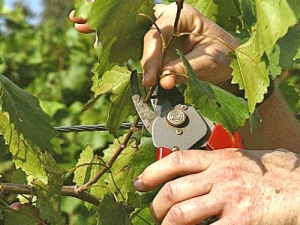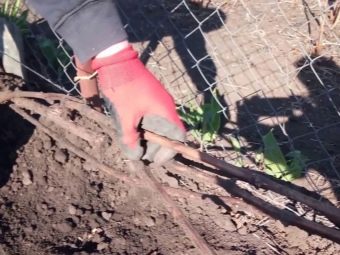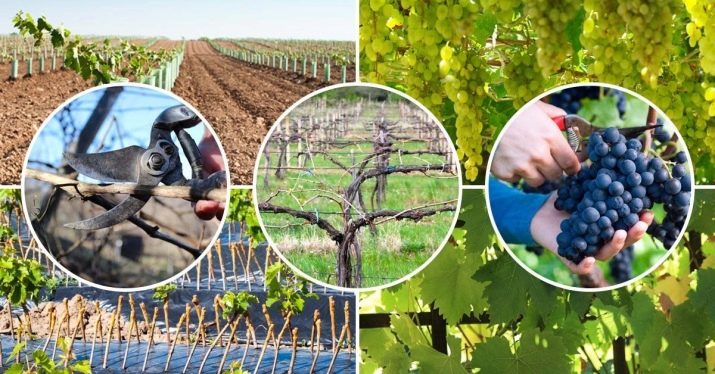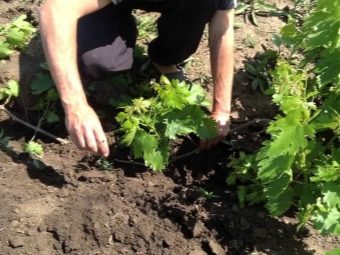Rules for the care of grapes in spring

If you decide to choose viticulture as your occupation, you should be prepared for the fact that caring for this rather capricious plant will take you a lot of time and money. Of course, experience comes only with personal practice, but do not neglect the advice of those who have been doing this for a long time.
In our article you can familiarize yourself with recommendations on spring care for seedlings, as well as typical mistakes made by beginners. We hope that our advice will help you avoid them and get a great harvest.
Stages
It is better to postpone the purchase of young seedlings until mid-May. Carefully inspect the proposed bushes. They should look healthy and have no visible damage. Leaves must be present - at least six.
After planting, the gardener's work does not end at all. To understand how to ensure a good and tasty harvest, you need to familiarize yourself with some stages of crop care.
Opening
If you are already a happy owner of a vineyard that you sheltered for the winter, each bush should be “unpacked” and prepared for the summer season. Begin disclosure only after the average daily temperature has steadily established above zero degrees. And even then the procedure is carried out in several stages, gradually removing the covering material layer by layer. After opening the bush is tied up.
If the spring is rainy, the plant can get sick, so it is very important to pick up and fix all the twigs at some distance from the ground.
Spraying
This is done in order to protect the plant from parasites and to prevent possible diseases. Treated bushes with specially developed chemicals. You can spray them both the vine itself and the soil around the plant.
The soil is thoroughly irrigated with a special agent. Processed as a plot of land under a bush, and between the rows. Further, the soil must be mulched, but without loosening.
Consider the most common drugs used for tillage.
- Iron sulfate, concentration 3%. It is used as a protective agent in case of a sudden cold snap. Protects the kidneys from freezing for seven days.
- Bordeaux fluid, concentration from 1 to 3%. With her you have to be extremely careful. The higher the percentage of concentration, the more toxic it is. In addition, observations show that this fluid slows down, and sometimes stops the growth and development of new processes of the vine. Therefore, its use is considered by many to be inappropriate.
- "Ridomil". Well proven and low toxic drug. Its action does not stop even in rainy weather, the remedy can stay on the plant for 2 weeks. Suitable for processing both sapling and the land around it.
- Preparations "Bactericide" and "Fungicide". The safest chemicals, harmless neither to humans nor to our smaller brothers. And they do not cause the slightest harm to the plant. Used as prophylactic against fungi and bacteria.
Pruning
First, be sure to purchase the necessary tools for cutting the vine - pruner and saw. Secondly, start “trimming” the bushes in April (we are not talking about newly acquired seedlings, but about those who spent the winter on your site) when the vine is poured with juice. Get rid of all dried and unviable shoots and bushes. Keep an eye on the sharpness of the tool so that it cuts, rather than flattening, the cut branches.
If your bush is 2 years old or more, cut it off so that half of the young seedlings will be removed. Leave 3 escapes, no more. Cut from each of the 5 buds, moving from the beginning of the bush.
Next, form the “backbone” of the plant. This is done, of course, by cutting off all that is superfluous. There must remain a “spine,” that is, a trunk, and “shoulders,” strong branches, on which new shoots will subsequently grow and a bunch of grapes will appear.
A truly high-quality pruning of the vine looks like this: on top, on the “shoulders” leave a small last year’s branch with new shoots. From below the branches are shortened a little; up to six buds are removed from the top of the vine.
In order to prevent infection by pathogenic bacteria and viruses, cut-off sites are treated with garden pitch.
Top dressing
Plant nutrition with various mineral additives depends on the phase of its development. In the spring, when the vine enters the initial growth stage, it needs nitrogen. In early summer, when the flowering and ovary of the berries starts, phosphorus-containing preparations will be helpful.Boron helps to increase the sweetness of berries, ripening occurs faster. Zinc will help harvest a richer crop.
With the onset of autumn, the bush will need copper and potassium, the plant that they feed will tolerate the winter cold much better.
More grapes need calcium, iron, magnesium, sulfur. However, these minerals are often enough in the ground and the bush should not be overfed by them.
After winter is gone, do the following: take 20 g of superphosphate, 10 g of ammonium nitrate, 5 g of potassium salt, mix them, dissolve in 10 liters of water, and arrange each bush for personal watering.
Manure is also useful to the vine. Prepare the solution and water your plants. Manure contains beneficial microorganisms and contributes to soil aeration.
When the bushes begin to bloom, they should be watered with the same mixture of mineral additives that you used after the winter.
Maintenance work
The first routine inspection and treatment of the vine should be carried out before the buds swell. That is, approximately in the beginning of May. Do not forget the fact that in different climatic zones this occurs at different times, so just follow the development of your bushes, so as not to miss this moment.
The air temperature should rise to 5 degrees Celsius. Treat the vineyard with copper sulphate, with a concentration of not more than 3%. A couple of weeks later, after the formation of the first leaves on the bushes, you can apply a fungicide. His solution must be carefully sprayed all plants.
The second preventive measure will be processing the vineyard a week before flowering. Since the most common diseases of grapes are false and true powdery mildew, all bushes will need to be treated with preparations containing sulfur and copper.
If suddenly your plants overcame a tick, immediately get rid of it with the help of drugs-acaricides. Of course, this must be done before the beginning of the ovary of flowers.
Features in different regions
Due to the enormous size of Russia, the procedure for growing grapes may vary in its different regions. To choose the right approach to caring for this plant in your particular case, consider the nuances of the climate in which you live. Only then can you harvest a good crop from your vineyard.
Take, for example, several regions in order to understand the differences in agricultural technology for each of them.
- In central Russia with its changeable weather conditions, the grapes, oddly enough, grow pretty well. Of course, if you properly care for him. Open the vine here is not earlier than mid-April. One week after opening, the bushes are watered with nutrient mineral solutions. Well, then they do all the things mentioned above.
- Northwest part of our country characterized by a rather short period, suitable for growing grapes. It starts to open in May, and the "autumn" pruning is performed in mid-August. By the end of September, it should already be covered and prepared for wintering.
- In the Volga regionWith a cooler spring, the procedures are shifted to the beginning of the month of May. In order to avoid the death of plants due to sudden frosts, a kind of shelter is built over them, like a greenhouse, consisting of a rigid semicircular frame and plastic film. Every day, polyethylene is removed and the bushes are allowed to breathe and get used to the outdoor temperature, gradually increasing the period of being open.
- Ural and Siberian frosts merciless towards the tender vine, however, with the right approach to its cultivation, even in these regions you can get a good harvest. Here, the opening of the bushes is also carried out in the beginning-middle of May and a mini-greenhouse is also being constructed for them. The difference in the care of grapes in a warm climate and in a cold one is the absence of top-dressing with nitrogen-containing preparations in the north. In general, instead of multi-feeds, monofeed feeds containing one mineral component are used.
- Far East of Russia also not spoiled by high temperatures. On the contrary, the spring is lingering and cold here, with frequent frosts. It was here that the most cold-resistant grape variety, Amursky, was bred. However, besides him, other cultivars are also trying to grow here. In order for the seedlings not to die, the opening is not made until May, and they do it gradually, covering them with polyethylene. It is recommended to have vineyards from east to west - only in this case they will get enough sunlight and heat.
- well and in Crimea, in one of the warmest points of Russia, growing, perhaps, the best grapes in the country. Not surprisingly, the Crimean wines are known throughout the world!
The most extensive areas are vineyards in the Bakhchisaray and Simferopol districts, as well as in the suburbs of Yalta, Alushta, Sudak. In these places, the most fertile soil is rich in precisely those minerals that are needed for grapes.
The air temperature in Crimea rarely drops below 10 degrees Celsius, so the vine grows so well here. According to the latest data, more than thirty varieties of this culture are grown in these places.
Errors
Inexperienced beginners often make a lot of mistakes, especially at the very beginning of their activities. That is why they need to first read the following list of the most common mistakes, so as not to repeat them and not feel the bitterness of disappointment from the failed case.
So, here are these errors:
- non-compliance with the timing of the opening of the bushes;
- lack of moisture irrigation;
- small pruning of a bush or pruning only a young growth on it;
- the neglect of professional examinations and processing from harmful parasites and bacteria;
- attaching the vine to the trellis with a wire or coarse thick rope.
Seasoned gardeners give a lot of advice to beginners and those who are interested in this topic.
- Before you purchase the selected variety of seedlings of grapes, read the detailed information on caring for them and its capabilities. As far as this variety is choosy, thermophilic, what necessary conditions must be met in order for it to take root and begin to bear fruit. It is very important to choose the most suitable place for planting seedlings. It is logical that it should be warm, with good lighting. The best option for placing the plot under the grapes is south or southwest.
- Next, you must decide how you can protect your vine in bad weather, such as rainstorm or gale. A fence built nearby will be one of the protection factors.
But plant grapes away from large trees, as in this case, your vine will not receive the necessary amount of minerals from the soil.
- Find out what more in the soil in which you are going to plant grapes - acids or alkalis. And then make sure that the selected variety loves just such a soil. Thus, most species cultivated in Europe and Asia prefer alkaline soil, while American varieties tend to be more sour.
- Excess moisture will destroy the vine. Never plant grapes in swampy areas or in areas with high underground waters.
- Choose only the variety that really can take root in your climate. Perhaps its berries will not be so large and sweet, but, in any case, you will get a harvest without much effort.
- Grapes love heat. In order to create the most comfortable conditions for growth and development, plant it on the sunny side, make artificial barriers around, be prepared to build a mini-greenhouse for it. Extend the pleasure of warmth to your bushes, even if they are comfortable in the fall.
- There is such a very effective "life hack", quite simple in execution. Take the bottles (only glass, others will not fit!) And stick them into the ground next to your bushes, strictly neck down.The sun's rays, which will fall on the glass, will heat it, and heat will be transmitted to the roots.
- Do not plant grapevines at a distance of less than a meter from each other. Vine tends to grow and if the bushes stand close, they will receive less of the sun, eventually grow frail and unviable.
- It is very important to find the “golden mean” when watering the vineyard. This plant does not like overmoistening, but it will not last long in dry soil. Therefore, it is necessary to regulate the amount of moisture supplied.
- After harvesting the first harvest in the fall, prune the vine. Leave on each bush 2-3 good shoots that can be poured in the spring. Also, since grapes are a plant that can reproduce by cuttings, you can also prepare them just in case. You can store cuttings in the cellar, wrapped in plastic and making holes for air circulation.
- Starting from the second spring, your vines will enter a stage of active growth. Therefore, in order to avoid their breaking off under the weight of bunches, do not forget to tie them up. The angle of inclination of the plant should be approximately 45 degrees.
- Carefully monitor the health of the bushes. At the slightest suspicion of defeat by parasites, treat them.
- Periodically feed your "pets", but without fanaticism. Do this with equal intervals and little by little.
So, we have tried to tell you in more detail how to care for grapes in the first year of his life. But what could happen next.
If you did everything right, then by the end of the season the bush will be strong, with a strong stem, a succulent vine and strong roots. It is necessary to cut and leave 2-3 escape for further development. Do not forget to process all the slicing sites to prevent infection.
The second spring your grapes will meet with new fresh shoots. They are now considered two-year plans, respectively, are not subject to pruning, but, on the contrary, are the "suppliers" of new shoots. In the second year we form the “main” bush.
With the arrival of the third spring begins tying. The plant grows, becomes larger, more and more determined its final form. Watering the grapes is now possible less often, especially if there is no problem with rain in your area. When the bushes are in bloom, as well as during the harvest, watering should stop at all. They have enough watering every 2 weeks, for each plant at the same time have to spend about 6-8 liters of water. It is advisable not to pour it directly under a bush, but to dig a small trench at a distance of no more than half a meter, pour water in there, dig it in and bury it a little.
Make sure that your grapes do not let the root system out. The roots are dry from sunlight or frozen in the winter cold and the plant will quickly die. Even to cover such a bush does not make sense.
Any plant likes care and care. Wild or cultural - it will not grow and bear fruit in unsuitable conditions for it. Therefore, if you decide to start growing grapes - whether for yourself or for commercial purposes, you must take care to create all conditions for your vineyard to grow and prosper.
Acquire training literature, watch educational videos, visit gardening forums and meetings, get acquainted with new products in the field of fertilizers and fertilizing for grapes - in general, use and use all means to get the necessary amount of knowledge.
All about the care of grapes and the formation of the bush in the spring, see the following video.








































